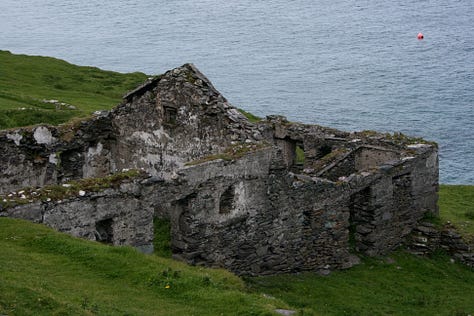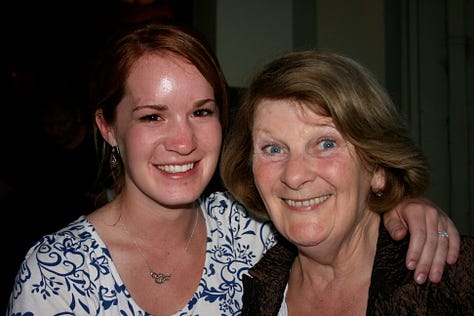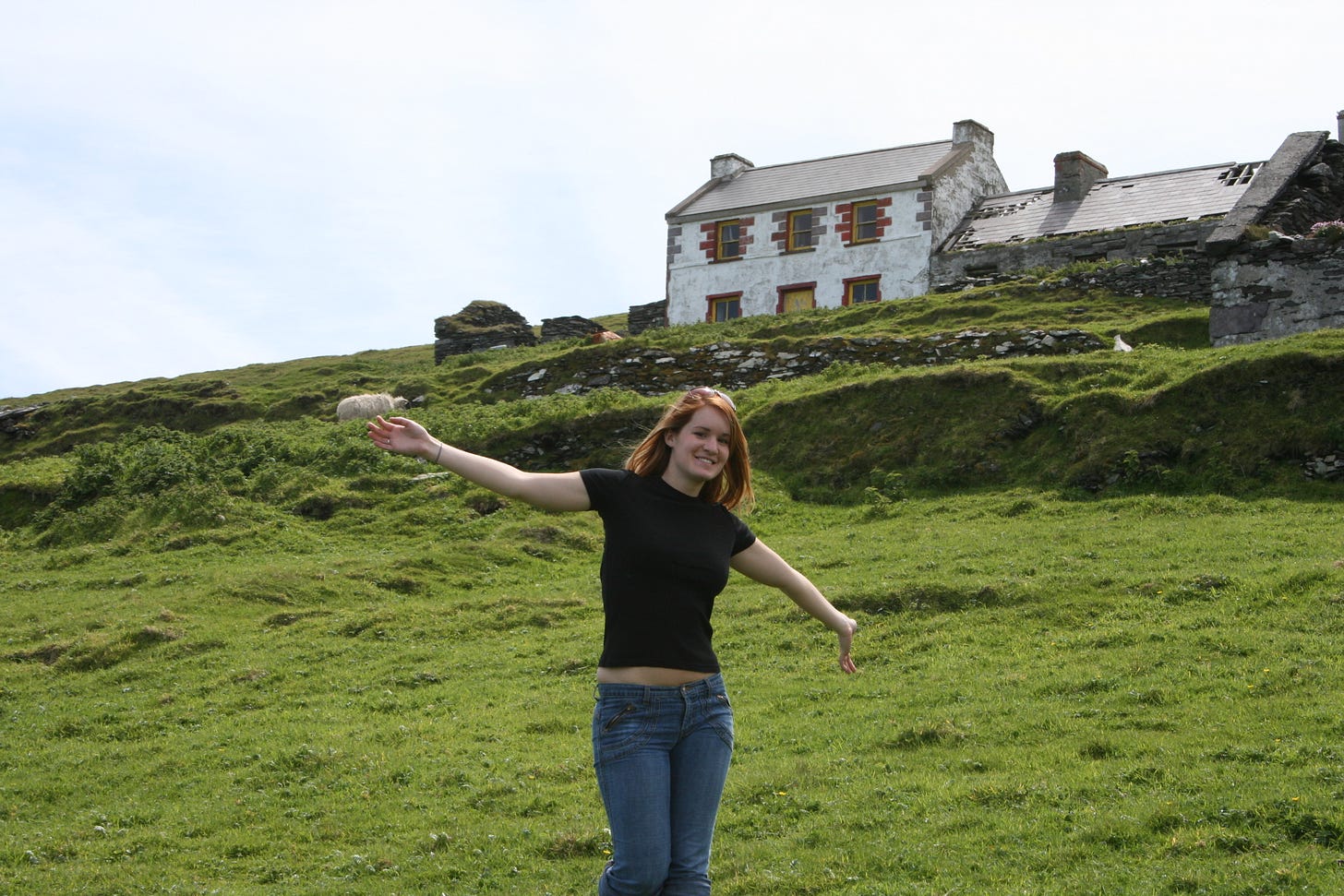"I was born in the Blasket Island..."
It's a long way from there to here
This morning I read in the Irish Times Weekend Magazine that Máiréad Ní Chearnaigh Uí Shé died in Springfield, Massachusetts, aged 102.1 She was the last of the generation that had emigrated from the Great Blasket to Springfield in the 1940s and ‘50s. I have since spent the day remembering the summer of 2007 when I took a group of 20 university students to the west coast of Ireland for a two-week study abroad. We started in Clonakilty, West Cork and traveled up the coast through Kerry, Limerick and Clare with a four day stop on Inis Oírr, another of the western islands. It was a memorable trip for us all. But for one young woman in particular, it was far more than that.
On the evening we landed in Dingle town, one of my advisees, Caitlin Foley, handed me a photo of a white-washed house perched up on a hill and asked me if we’d be passing this house the next day on our trip out the peninsula. This house was where her grandfather had lived before he came to America in the 1950s. As there are dozens of houses like it on the coast road, I decided to ask the owner of the guest house where we were staying if she knew the house. She wasn’t entirely sure and I suggested that maybe Maura of the beehive huts in Fahan might be able to help us.
I had known Maura for some years and, whenever I was in the area or leading a group of people around that part of the country, I would stop in for a chat and a cup of tea. She was quite the character but I didn’t have her phone number or any way of getting in touch as I had all these students in tow. Our landlady got straight to work, first asking a few people in the adjoining pub if they knew whether Maura was “at home” or away visiting her children in other parts of the world. Several phone calls into the process, I said, “You’re very kind to go to all this trouble.” She looked at me, quite seriously, and pointing at Caitlin said, “Sure, isn’t she one of our own?”
This is the remarkable thing about the people of the Dingle Peninsula—the decades of emigration, especially from the Blaskets and Dunquin, haven’t weakened the ties that bind them. These ties are so strong that even those who are now an ocean away are deeply connected, as are their children and grandchildren. Their leaving was not a matter of choice or adventure in most cases, but dictated by a mosaic of factors: accelerating modernity, economic opportunity and, in the final chapter, government policy. There are many books written about Irish emigration in this period so I won’t go in to that here. This is a personal story.
At breakfast the next morning, our landlady confirmed that Maura was indeed at home and would be delighted to meet with Caitlin when we stopped at the beehive huts. I brought her up to the house while my colleague herded the rest of the students around the ancient stone buildings that were scattered around Maura’s homeplace. Maura immediately pulled out photo album after photo album, some featuring pictures of herself with various celebrities who had visited Fahan, but most that had photos of her girlhood friends and relations, including Caitlin’s grandfather. We were there for over an hour and finally, awash with cups of tea, smiles, tears and embraces, we got back on the motor coach to head over to The Great Blasket Heritage Centre. On the way out, Maura asked could I video a message to share with Caitlin’s folks back in Springfield.
On arriving at the Heritage Centre, I asked for Micheál de Mórdha, the director of the centre. I introduced him to Caitlin explained her relationships and he whisked her away to his office where he proceeded to tell her much more than she could take in, print off copies of photos, bits and pieces describing the house her grandmother lived in, the family relations—it was, frankly, a bit overwhelming, but very warm and friendly. Micheál also wanted to send a video message:
I think the most moving part of the Heritage Centre was the last room at the end where a replica of a 1950s kitchen from Springfield, Massachusetts was set up.
From the Heritage Centre we went the short distance to catch a boat that would bring us out to the Great Blasket island itself. With warnings to “watch your step,” “don’t fall off any cliff edges,” and “please don’t disturb any of the ruins or cottages—this is a heritage site,” my colleague and I left them off to explore the island. They went off in twos and threes—all except Caitlin. Up to now she could always be found in a gaggle of three or four girls, laughing and chatting. But here, on the island where her grandmother was born and reared, she took a solitary walk around the hills and fields, seeking out the schoolhouse where her great-grandfather was the teacher, where the friends of her father and mother used to live before they left for America, deep in thought and emotion. I watched from a distance but left her to wander the actual ground of her ancestors.
Exhausted from the sea air and starving from the exercise of walking the island, we took the boats back and climbed into the motor coach for the trip back to Dingle town. As Caitlin passed me on the way to her seat, she said softly, “I had no idea.”
- - - - -
Fast forward to the end of the fall semester when my advisees and I sat down to plan the program for their last semester. Caitlin arrived looking to do an independent study project. After some discussion of various possibilities, I said,”You know, you have a unique opportunity to do something few people are in the position to do,” and suggested she might want work on an ethnographic project on her own community, those who emigrated from the Great Blasket. Many have interviewed them about what life was like in Ireland but not no one to my knowledge had explored their lives here. How they adapted, what of their culture was still with them, what did they leave behind?
And that is what she did. One of her interviews was with Martin Kearney; the other was with Máiréad. She struggled with Audacity, started a few posts on BlogSpot and got the first draft done. It’s still there but, due to paradoxically ephemeral nature of the web, I’m going to recreate (and copyedit) and archive her three entries and the original transcripts along with the video clips she made but never got to process before heading off for her Master’s program. While the finished project was incomplete, the material she gathered was priceless. Well worth the journey.
Máiréad Ní Chearnaigh Uí Shé
1922 - 2025
Ar dheis Dé go raibh a n-anam
— — — — —






As I walked up to the ruined houses of the Great Blasket Islands it was as if I was looking through a peephole into another person’s life.
And I was looking at that place I said, "America! Holy mackerel! All the lights."
I said, “What am I going to do? I’ll be lost forever.”
Yes. Everybody left then... everybody was gone there. Nobody was there then but the rabbits.
https://www.irishtimes.com/life-style/people/2025/08/15/island-escape-the-couple-living-the-good-life-on-the-blaskets/

